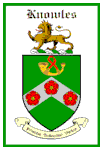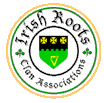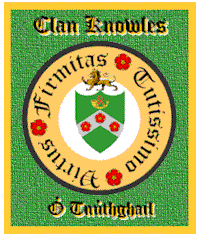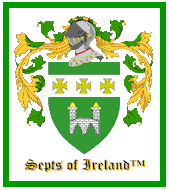|
|
With few exceptions, your current surname may not be close to your historical surname. Many times, census takers and ship's clerks spelled your family name phonetically. Some examples below.
| Knowles | Ó Tnúthghail | Newell | O'Knowell |
| Cussen | Quishing | Cushion | Cushing |
| Henneberry | de Hynteberge | Henebry | Hembury |
| Kinney | O' Kenny | MacKinney | MacKenna |
| Magner | Magnier | Mangel | Magnes |
| Kiely | Queally | Kealy | Kelly |
The history of the Knowles surname is divided into four main areas.
| 1. The early Viking/Norman/French surname of Cnolle. |  |
"The name carries us to the gently rising slopes in the woods, grassy and free of timber, the old form of Knowles being de la Cnolle which means of the hill." Also termed as at the knoll or summit. Early Norman/French versions of the surname are: Robert de la Cnolle: 1185, Thomas Knolle: 1279, Sir Robert Knowles: 1317.
By the early 700's, the Vikings' ship building technology had
developed the capability to allow masts and sails on their ships. This
advancement allowed them to travel farther distances, and they begin attacks on
Ireland in 795. The native Irish did not build towns. It was the
Vikings who established Dublin and Limerick and other towns and villages in
Ireland. The Vikings (Norsemen) were often called Danes by the Irish, but
the majority were Norwegian. The land of the Vikings was called "Lochlann".
The Normans were Vikings who established settlements in France during the
late 9th century. The consistent attacks on the Franks in 888
provided opportunities for new settlements in what later became known as
Normandy. The medieval Latin name for Viking is
"Northmannus" and the name for Normandy is "Northmannia"
(Viking Land).
The first Irish were neolithic
users of flint and then bronze. About 350, the Gaelic Celts from southern
France and Spain conquered Ireland. The Celtic traditions and culture have
held on longer in Ireland than any other country, and the Vikings and Normans
became absorbed into the Gaelic world.
| 2. Knowles in England. |  |
Domesday Book of 1086 by William the Conqueror has a listing for a landowner in Lancashire with the surname Knowlsey.
Another version is the Anglo/Saxon origin of the Knowles name from Yorkshire records in the 12th century.
The Harleian Manuscripts are the records of the "Visitations" (the investigation of heralds) of English and Welsh families. The manuscripts were complied from about 1530 to the close of the 17th century. Over 30,000 families registered their lineage which are now housed in the British Museum in London. The Knowles surname is listed in several counties.
The largest group of the Knowles surnames occurs in England. Sir Robert Knowles (1317-1407) English leader of free companies in France in opposition to DuGuesclin. John (Jean Le Vaillant, or Le Conquerant), duke of Brittany from 1365, whose support for English interests during the Hundred Years' War (1337-1453) nearly cost John the forfeit of his duchy to the French crown.
|
|
 |
The name Knowles in Ireland is often of immigrant origin having been brought into the country by English settlers who arrived into the Province of Ulster, especially during the seventeenth century. The Cappoge Castle in the parish of Castleknock, County Dublin had been forfeited after the rebellion by Bartholomew Dillon, and the chief inhabitants on the lands after the Restoration were Captain Knowles and Henry Wood, whose house was assessed for two hearths. At the time of the Restoration (1660-1666) the inhabitants numbered four of English and 22 of Irish descent.
In Ulster, particularly in Down, the name is considered English. One English family of the name is found in Kinsale, Co. Cork, settled in the 17th century.
Newell (Knowles) 
Both Newell and Knowles are, of course, also common English surnames. Three men called Knowles, relatives of Richard Brinsley Sheridan, of whom James Sheridan Knowles (1784-1862) is the best known, were distinguished in various branches of literature in the nineteenth century. Three Newells, too, all from the Belfast area, are noteworthy: one Edward J. Newell (1771-1798) admittedly only as an informer, but Alexander Newell (1824-1893) was a distinguished scientist and Hugh Newell (b.1830) an artist of repute in America.
Though found in all the provinces this name is common only in Ulster where it is most numerous in counties Down and Antrim. It can he of English or Scottish origin. Newell can be a variant of either Nevill or Noel. One prominent English family, the Nevilles of Raby, came from Neville in France. Most others took their name from one of the several places in France called Neuville. The name Noel is from the Old French Noel, which means 'Christmas', and denoted a person born at that time.
As Neuall, Newall and Newell, the name has long been found in the Scottish province of Galloway, especially in Dumfriesshire, whence hailed so many of the Plantation settlers.
The most famous of the name in Ulster history was Downpatrick man Edward John Newell, 1771-98, a portrait miniaturist. He joined the United Irishmen but was distrusted by the leadership. He became an informer. Rather foolishly he wrote The Life and Times of Newell, the Informer which was published privately in Belfast. He was about to leave Ireland on a government passage when he was assassinated.
| 4. O'Tnuthghail - Knowles |  |
The ancient Gaelic septs of County Kildare were descended from Cathaoir Mor, King of Ireland, who died in 122 AD. One of the four major septs of Kildare were the Ui Ciardha (O’Careys/O’Kearys), who had lands in North Kildare around the present day barony of Carbury. The territory was named Cairbre (Carbury), after one of the seven sons of Niall of the Nine Hostages, who was king of Ireland at the end of the fourth century.
 |
Within the territory of
the O' Carey's lived the native Gaelic Ó Tnúthghail Sept of North County Kildare who sometimes anglicized their name as
Knowles as well as the more usual Newell.
Anglicized form of Gaelic Ó’Tnúthghail, ’descendant of Tnúthgal’, a personal name composed of the elements tnúth ’desire’, ’envy’ + gal ’valor’. |
Spelled as Knowles the name is found in County Cork in the 1659 Census, and in Dublin and Antrim in the more modern 1890 index. The 1659 census shows as well, the spelling of Knowle, also in County Cork. There was an old Irish sept in county Kildare by the name of Newell, which may be corrupted to the above spelling.
This family name is given in County Cork in the census of 1659. Knowles is given in the Census of 1659 in Co. Cork. Several of the 'Knowles' name are given in an 1851 census of the Union of Kilworth in Co. Cork in the townland of Monedrisane. The name is also given in at least one instance in the 'barony of Barymore', Co. Cork in 1659. James Sheridan Knowles was a noted dramatist and author of a Dictionary of the English Language. He was born at Cork in 1784.
Ireland was one of the earliest countries to evolve a system of hereditary surnames. They came into being fairly generally in the eleventh century, though some were formed as early as the year 1000. Brian Boru, high king of Ireland, who died at the Battle of Clontarf in 1014, is often erroneously credited with decreeing that the use of surnames should become a requirement among his subjects. In fact the system developed spontaneously in Ireland, as it did elsewhere, as a result of the need for personal identification in an increasing population.
The difficulty with establishing an Irish pedigree is that the Central Repository of Ireland's Public Records was set on fire and burned in 1922. The main bulk of the State, Domestic and Ecclesiastical Records of the country were then destroyed.
Sept and Clan
The terms clan and sept have often been confused. Ireland never had a well developed clan system like Scotland. "Sept" is more appropriate as a collective term describing a group of persons or immediate ancestors who bore a common surname and inhabited the same territory. Clan is often used today to indicate the family group.
Source: Edward MacLysaght, Irish Families, Dublin: 1991. Bibliography



